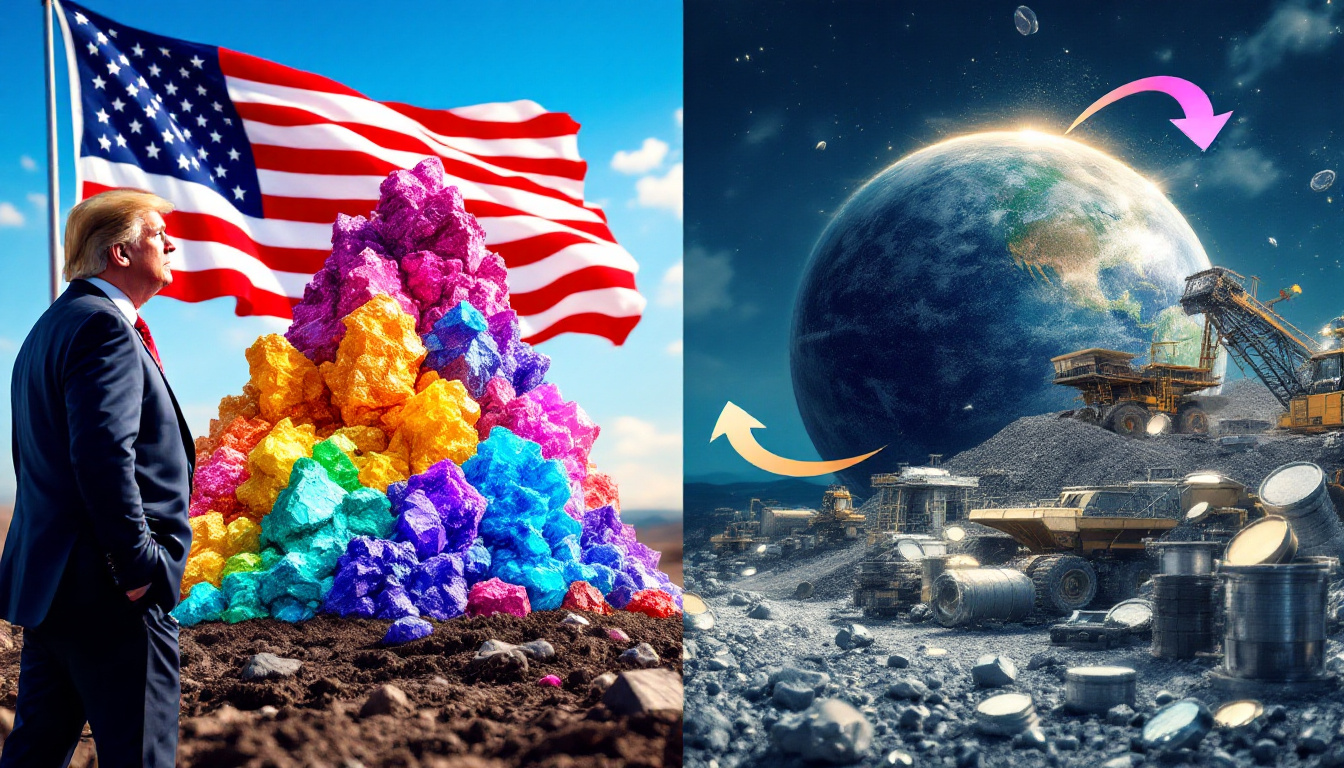Understanding Trump's Executive Order on Critical Minerals
In a significant policy shift aimed at revitalizing America's mineral independence, Trump's recent executive order on critical minerals has ignited discussions across mining, manufacturing, and national security sectors. The order targets over 50 minerals deemed essential to America's economic and strategic interests, adding copper, potash, and gold to the existing USGS list. This comprehensive approach represents what many industry experts consider the most ambitious attempt to resurrect domestic mineral production in decades.
The National Energy Dominance Council, established in February 2025, will spearhead the implementation of this sweeping directive. According to Erez Ichilov of Cedrus Arbor, "The onus is on all of us in the industry to assure rapid deployment of these critical resources for America's future." This sentiment reflects the urgency felt across the minerals sector as the U.S. seeks to reclaim its position as a global minerals leader.
John Gross from the Copper Journal called the order "a big step in the right direction," though he noted some confusion around concurrent tariff policies that might affect implementation timelines.
What Are Critical Minerals and Why Do They Matter?
Critical minerals encompass a diverse range of elements essential for everything from defense systems to renewable energy infrastructure. The current classification includes the USGS's 50 designated minerals plus recent additions of copper, potash, and gold—recognizing their foundational role in modern technology and infrastructure.
The strategic importance of these minerals cannot be overstated. As stated directly in Trump's executive order, "Our national security is threatened by foreign mineral reliance." This concern stems from a dramatic reversal of America's resource position—a country that once dominated global mineral production now depends heavily on imports from nations often categorized as "hostile foreign powers."
This dependency creates multiple vulnerabilities. For instance, aluminum, one of 11 minerals on the Department of Defense's critical list, illustrates the challenge. Despite being abundant in American soil, processing capacity has diminished over decades, forcing reliance on overseas suppliers. The current global mineral landscape presents a stark contrast to America's historical position as the world's mining powerhouse before the regulatory expansion of the 1970s and 1980s.
Beyond defense applications, these minerals form the backbone of the renewable energy transition. Electric vehicles require six times more minerals than conventional vehicles, while wind power plants need nine times more mineral resources than gas-fired plants—making addressing critical mineral shortages impacting the global clean energy transition increasingly important.
Key Components of Trump's Executive Order
Expedited Permitting Process
The order establishes a streamlined regulatory framework with ambitious deadlines: a Request for Information by March 20, the inaugural National Energy Dominance Council meeting in late March, and comprehensive agency implementation plans due by April 15, 2025. This accelerated timeline aims to dramatically reduce the current 7-10 year permitting process that industry experts identify as a major obstacle to domestic development.
Federal agencies must coordinate responses under a unified directive, eliminating the fragmented approach that has historically delayed mining projects. As William Adams of Fastmarkets noted, this represents a "super-charging of producer response" through regulatory efficiency rather than purely financial incentives.
Supply Chain Resiliency Initiative
Perhaps most strategically significant is the Supply Chain Resiliency Initiative, which extends beyond domestic borders to create bilateral and multilateral alliances with "friendly nations." This approach acknowledges the geological reality that not all critical minerals can be sourced domestically in sufficient quantities.
The Minerals Security Partnership framework established in the order provides a mechanism to secure feedstock for midstream processing—addressing a crucial gap in the mineral supply chain. This represents a sophisticated understanding that mineral security isn't just about mining but encompasses the entire processing infrastructure.
Financial Incentives and Support
The order directs federal funding mechanisms comparable to those in the Inflation Reduction Act toward critical mineral development. Industry observers note this approach effectively "throws money at the problem" in a manner similar to existing clean energy incentives, but with a distinctive focus on supply chain independence.
Investment opportunities will target domestic production facilities, with particular emphasis on processing capabilities—an area where America has fallen significantly behind global competitors. Unlike previous initiatives that focused primarily on exploration, this directive emphasizes the "mine to metals" approach that industry leaders like Australian Strategic Materials have proven successful in international markets.
How Will This Impact Specific Mineral Markets?
Base Metals and Battery Materials
The executive order's recognition of copper as a critical mineral represents a significant victory for industry advocates who have long argued for its classification as strategically essential. This acknowledgment could trigger expanded domestic production capacity, potentially moderating price volatility in a market essential to electrical infrastructure.
For aluminum, already on the Department of Defense's critical list, the order provides regulatory relief for expanding smelting operations. The Aluminum Association welcomed these measures as essential for rebuilding domestic self-sufficiency in a metal fundamental to aerospace, automotive, and defense applications.
Battery materials face particularly acute supply challenges. Despite ambitious EV production targets, domestic lithium, cobalt, and nickel production remains insufficient for projected demand. While permitting reforms might accelerate project development, one base metals trader cautioned: "The infrastructure simply won't exist for 5-10 years, regardless of how quickly permits are approved."
Rare Earth Elements
America's position in rare earth elements (REEs) illustrates the broader minerals challenge. Despite discovering many of these elements and once leading production, the U.S. now relies on imports for approximately 80% of its REE needs, primarily from China.
Current domestic production limitations extend beyond mining to processing capabilities—a more technically complex and capital-intensive aspect of the supply chain. The executive order specifically targets this gap through processing facility incentives.
Australian Strategic Materials' "mine to metals" strategy offers a potential model for U.S. implementation. As Rowena Smith, ASM's representative, explained: "Our Korean processing plant demonstrates the viability of creating a complete rare earths value chain outside China. We're actively exploring replicating this model in the United States." This approach aligns with the global rare earth reserves and investment insights that are shaping the industry.
Industry Reactions: Praise and Concerns
Positive Responses
The mineral industry has largely welcomed the executive order's comprehensive approach. Erez Ichilov of Cedrus Arbor praised its recognition that "permitting reform alone is insufficient without addressing the entire value chain." The Aluminum Association similarly endorsed the self-sufficiency measures as essential for national security.
International support has emerged from companies positioned to benefit from expanded U.S.-allied mineral cooperation. Australian Strategic Materials highlighted the order's alignment with their existing efforts to develop rare earth processing outside China, seeing opportunity in the U.S. market. Similarly, Australia has demonstrated commitment to this sector with the Australian government's $400 million boost to Iluka's rare earth refinery, showing allied nations' parallel interests.
Industry analysts note that the order's holistic approach—addressing permitting, processing, and international partnerships simultaneously—represents a more sophisticated understanding of mineral security than previous initiatives focused solely on exploration or regulation.
Critical Perspectives
Despite broad industry support, critical perspectives highlight implementation challenges. A base metals trader with extensive mining experience emphasized: "Even with perfect permitting, the processing infrastructure won't materialize for 5-10 years. These are highly technical facilities requiring specialized workforce development."
Marex analyst Ed Meir raised concerns about market fundamentals: "Permitting is secondary to market prices in determining project viability. If global prices don't support investment returns, regulatory changes alone won't trigger development."
Geological realities also constrain domestic production potential. Despite America's mineral wealth, not all 50+ critical minerals exist within U.S. borders in economically viable concentrations—highlighting the importance of the international partnerships component of the order.
What Are the Implementation Challenges?
Infrastructure Development Timelines
The current state of U.S. mineral processing infrastructure presents a formidable challenge. Decades of capacity migration overseas has left significant gaps in the domestic supply chain, particularly in specialized processing facilities for rare earths and battery materials.
Realistic timeframes for building new facilities extend beyond regulatory approval. As industry experts note, constructing and commissioning a rare earth separation plant typically requires 4-6 years after permitting—explaining the 5-10 year implementation timeline cited by multiple industry sources.
Technical expertise represents another constraint. The specialized workforce required for mineral processing operations has diminished in parallel with production capacity. Rebuilding this human infrastructure will require targeted educational initiatives and international recruitment from countries that have maintained these capabilities.
Economic Viability Concerns
Market price considerations ultimately determine project development regardless of regulatory efficiency. Capital intensive mineral projects require price stability to justify investment, particularly for processing facilities with high technical complexity.
Investment requirements for world-class processing facilities often exceed $500 million, with expected returns calculated over 15-20 year operational lifespans. This timeline exposes projects to multiple commodity price cycles, increasing investor risk perception.
Competition with established global suppliers creates additional economic challenges. Chinese producers in particular benefit from economies of scale, integrated supply chains, and lower environmental compliance costs—advantages difficult to overcome even with regulatory support.
Environmental and Social Considerations
The executive order explicitly acknowledges the need to balance expedited permitting with environmental protections, noting that development must proceed "while protecting air, water, and ecosystems." This recognition addresses a frequent criticism of regulatory streamlining efforts.
Community engagement remains essential for successful project development. The social license to operate—community acceptance of mining and processing operations—can prove as critical as regulatory approval for project viability, particularly in regions without recent mining activity.
Sustainability concerns in domestic mineral production extend beyond conventional environmental metrics to resource efficiency, water usage, and energy consumption. Modern processing facilities must incorporate these considerations to meet ESG requirements increasingly emphasized by investors and customers.
How Does This Compare to Global Critical Mineral Strategies?
European Approaches
The EU's Critical Raw Materials Act provides an instructive comparison, mandating that 10% of the bloc's annual consumption must be extracted domestically by 2030. This target-based approach differs from the U.S. order's emphasis on regulatory efficiency and investment incentives.
European research initiatives demonstrate alternative approaches to mineral security. The European Space Agency has explored extracting minerals from lunar regolith as potential substitutes for terrestrial germanium sources—illustrating how innovation complements supply chain development in comprehensive mineral strategies.
Regulatory frameworks differ significantly between the EU and U.S. approaches. While European policies emphasize mandatory recycling targets and sustainability metrics, the U.S. order prioritizes production expansion and processing capacity—reflecting different priorities in achieving mineral security. These varying global approaches are detailed in Trump's policies reshaping global commodity markets.
Asian Production Dominance
China's control of approximately 80% of global critical mineral processing represents the dominant reality in current mineral markets. This position resulted from decades of strategic investment rather than natural resource advantages, demonstrating the importance of processing infrastructure.
Japan and South Korea have pursued strategic investments in offshore mineral resources and domestic processing capabilities, providing potential partnership models under the U.S. order's international cooperation framework. South Korea's battery materials ecosystem offers particularly relevant lessons for U.S. development efforts.
Competition for global mineral resources has intensified as major economies pursue parallel security strategies. African cobalt, Australian lithium, and Chilean copper have become focal points of strategic competition, with supply agreements increasingly shaped by geopolitical rather than purely commercial considerations.
FAQ: Critical Minerals Executive Order
What specific minerals are covered under the executive order?
The order encompasses the 50 minerals on the USGS critical minerals list plus the newly classified copper, potash, and gold. Key categories include battery materials (lithium, cobalt, nickel), rare earth elements (neodymium, praseodymium), and industrial metals (aluminum, titanium, zirconium).
How will this affect consumer prices for products containing these minerals?
Short-term price impacts will likely be minimal as implementation proceeds gradually. Long-term effects depend on whether domestic production achieves sufficient scale to influence global pricing. Certain sectors, particularly EVs and renewable energy equipment, may see cost structure changes as supply chains evolve.
What is the timeline for seeing results from this executive order?
Regulatory changes will materialize within months, with agency implementation plans due by mid-April 2025. Project announcements and investment decisions may accelerate within 1-2 years. However, physical infrastructure development, particularly processing facilities, requires 5-10 years according to industry experts.
How does this order interact with existing environmental regulations?
The order maintains core environmental protections while streamlining coordination between regulatory agencies. It does not eliminate environmental review but establishes concurrent rather than sequential assessment processes. Water quality, air emission, and ecosystem protection standards remain in place.
What opportunities exist for investors in the critical minerals sector?
Investment opportunities span the mineral value chain from exploration to processing. Early-stage processing technology companies may benefit from federal funding initiatives. Established producers with permitted expansion projects could see accelerated development timelines. International companies with transferable processing expertise may find partnership opportunities as domestic capacity develops. For a broader perspective, see mining and finance industry predictions for 2025 for additional insights.
Future Outlook for US Critical Mineral Production
Short-term Impacts (1-2 Years)
Regulatory changes will likely produce the most visible initial impacts, with permitting timelines potentially halving for priority projects. This efficiency would particularly benefit advanced exploration projects nearing development decisions.
Initial investments and project announcements should accelerate as regulatory certainty improves. Companies with existing permits may fast-track previously marginal projects, while exploration budgets could shift toward critical minerals with stronger federal support.
Market price responses to policy changes typically precede physical production increases. Speculative investment in junior mining companies focused on critical minerals may drive equity valuations before operational improvements materialize—creating both opportunity and volatility for investors.
Long-term Transformation (5-10 Years)
Development of domestic processing capabilities represents the most significant potential long-term impact. If successful, the initiative could establish technological leadership in high-value segments like rare earth separation and battery material refinement.
Reshaping global mineral supply chains would extend beyond U.S. borders through the international partnerships framework. Allied nation coordination could create parallel supply ecosystems for critical minerals, fundamentally altering market structures currently dominated by Chinese processing capacity.
The potential for U.S. return to mineral production leadership depends on successful execution across multiple dimensions—regulatory, financial, technical, and diplomatic. While geological constraints limit complete independence, strategic leadership in processing technology and supply chain coordination remains achievable with sustained implementation of the executive order's comprehensive approach.
Ready to Stay Ahead of ASX Mineral Discovery Opportunities?
Don't miss the next market-moving mineral discovery announcement on the ASX. Discovery Alert's proprietary Discovery IQ model delivers real-time notifications on significant discoveries, transforming complex data into actionable investment insights. Explore our dedicated discoveries page to understand how major mineral finds can generate substantial returns for early investors.




